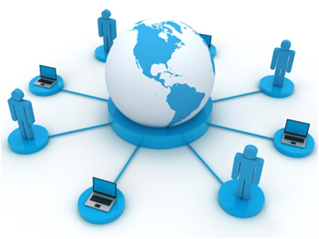Data Integration (Big Data and Real World Internet)
 In addition to the evolution of the more traditional uses and current trends of the Internet, the Internet is extending its reach to the real world through innovations collectively termed the Internet of Things (IoT). The IoT concept was initially based around enabling technologies such as Radio Frequency Identification (RFID) or wireless sensor and actuator networks (WSAN), but nowadays spawns a wide variety of devices with different computing and communication capabilities. While originating from applications such as supply chain management and logistics, IoT now targets multiple domains including automation, energy, e-health etc. More recent ideas have driven the IoT towards an all encompassing vision to integrate the real world into the Internet.
In addition to the evolution of the more traditional uses and current trends of the Internet, the Internet is extending its reach to the real world through innovations collectively termed the Internet of Things (IoT). The IoT concept was initially based around enabling technologies such as Radio Frequency Identification (RFID) or wireless sensor and actuator networks (WSAN), but nowadays spawns a wide variety of devices with different computing and communication capabilities. While originating from applications such as supply chain management and logistics, IoT now targets multiple domains including automation, energy, e-health etc. More recent ideas have driven the IoT towards an all encompassing vision to integrate the real world into the Internet.The basic idea underlying the Real World Internet (RWI) is that the ubiquity of mobile devices and proliferation of wireless networks will allow everyone permanent access to the Internet anytime anywhere. This wireless connection is not limited to user devices, almost any artefact from clothing to buildings can be connected and collaborate. Furthermore new sensor technologies and wireless sensor networks provide environmental intelligence and the capability to sense, reason and actuate. This leads to the vision of the interconnection of artefacts embedded in our real environment, forming a society of "intelligent things" and "smart spaces".
Among the research areas in this topic, the idea of networked knowledge and context is emerging. The level of detailed information will increase beyond any previously imaginable levels. Raw data generated by the trillions of sensors is just the beginning - this information is composable. Processors and services can aggregate and fuse this information to provide higher level contextual information, forming complex control loops or delivering real-time streams of accurate real world information for post processing or statistical information. What are the mechanisms that we need to filter and search this knowledge? What will be the traffic patterns that we have to deal with in addition to the commonly seen data traffic (email, web-browsing, IPTV) on the Internet and will the collective use of the Real World Internet impact these services? How can this data be modeled and represented? How can we compose new context information on the fly?
Our objectives in this research area are focused on the management and understanding of the raw data coming from heterogeneous sensor networks and data streams by means of semantic technologies. This data needs to be combined as well with static data coming from relational databases or other sources like Google Fusion Tables.
Projects
Currently we have one project in this area, PlanetData, as well as a Marie Curie staff exchange programme (SemData) and a national project (myBigData). Besides, we run several projects in the past in this context, such as the European project SemsorGrid4Env and the national project UpGrid, which we run together with iSOCO and Telefónica I+D.
Main results
The work done by our group in this research area has mainly focused on the development of the morph suite of technologies (together with their corresponding algorithms), which are focused on applying query rewriting techniques over mappings expressed in the W3C R2RML language. We can find the following components in this suite:
- morph-RDB, for accessing relational databases. Currently it provides support for relational database management systems such as mySQL, Postgres and MonetDB.
- morph-GFT, for accessing Google Fusion Tables.
- morph-streams, for accessing data streams available in Esper, GSN or SNEE, although extensible for other dynamic data sources that expose data through a REST API.
- SPARQL-DQP, for accessing federated SPARQL endpoints.
- kyrie, for enriching SPARQL queries by considering ontology entailments.
Some of the most relevant publications in this area are (to be completed soon):
- Sequeda, J F. Corcho, O. Gomez-Perez, A. (2009) Linked Stream Data: a short paper. 2nd Semantic Sensor Network Workshop at International Semantic Web Conference. Washington DC, US Link
Some presentations available in this area are (to be completed soon): "Semantics in sensor networks"
We have also worked on the generation of ontology networks that allow describing sensor networks and the data that can be obtained from them (this work was done under the context of the W3C Incubator Group on Semantic Sensor Networks).
We have also participated in the organisation of several events related to this topic, including some tutorials on semantics and data streams (http://semsensweb.di.uoa.gr, http://streamreasoning.org/sr4ld2013, http://streamreasoning.org/rsp2014).
Members
This research area is led by Oscar Corcho, and the team is composed by two postdocs (Raúl García-Castro and Alejandro Llaves), and the PhD students José Mora and Freddy Priyatna. Some older members of the group are Carlos Buil-Aranda (now in Universidad de Chile) and Jean Paul Calbimonte (now at EPFL).
Job opportunities
There are currently no job offers or studentships available in this research area. For offers in other areas of the group, check our job opportunities section. However, you may contact Oscar Corcho to check whether there are any potential open positions in the near future.
Created under Creative Commons License - 2015 OEG.

